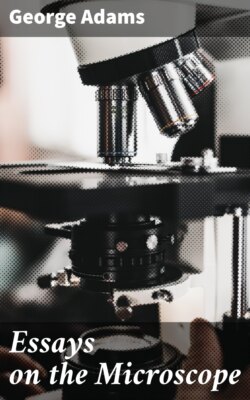Читать книгу Essays on the Microscope - George Comp Adams - Страница 50
На сайте Литреса книга снята с продажи.
DESCRIPTION OF A SMALL MICROSCOPE FOR OPAKE OBJECTS. Plate II. B. Fig. 3 and 4.
ОглавлениеTable of Contents
A, Fig. 3, is a fixed arm, through which passes a screw, B, the other end is fastened to the moveable arm, C. D, a nut fitted to the said screw, which, when turned, will either separate or bring together the two arms, A C. E, a steel spring, that separates the two sides when the nut is unscrewed. F, a piece of brass turning round in a spring socket, moving on a rivet, in which moves a steel wire pointed at the end G, and the other end a pair of pliers, H: these are either to thrust into, or take up and hold any object, and may be turned round as required. I, a ring of brass, with a female screw fixed on an upright piece of the same metal, turning on a rivet, that it may be set at a due distance when the least magnifiers are used, and is adapted to the screws of all the magnifiers.
Fig. 4, K, a concave speculum of polished silver, in the center of which a lens is placed. On the back of this speculum a male screw, L, is made to fit the brass ring I, Fig. 3. Four of these specula of different concavities, with four glasses of different magnifying powers, as the objects may require. The greatest magnifiers have the least apertures. M, a round object plate, one side white and the other black, intended to render objects the more visible, by placing them, if black, upon the white, and if white, on the black side. A steel spring, N, turns down on each side, to secure any object; from the object plate there is a hollow pipe, to screw it on the needle’s point G, Fig. 3. O, a small box of brass, with a glass on each side, to confine any living object in order to examine it, having a pipe to screw upon the end of the needle at G. P, an ivory handle. Q, a pair of pliers to take up any object. R, a soft hair brush.
To view any object, screw the speculum, with the magnifier you intend to use, into the brass ring, I; place your object either on the needle G, in the pliers H, on the object plate M, or in the brass hollow box O, as may be most convenient; then holding up your instrument by the handle P, look against the light through the magnifying lens, and by means of the nut, D, together with moving of the needle at its lower end, the object may be turned about, raised or depressed, brought nearer the glass, or put farther from it, till you have the true focal distance, and the light be seen reflected from the speculum strongly upon the object.[35]
[35] Opake microscopes are now constructed more elegantly and simply. The chief merit of Wilson’s microscope appears, in being particularly adapted to minute objects, and these principally of the transparent kind; the barrel form is useful for excluding adventitious light. Excepting these peculiarities, its general utility is considered far short of the universal pocket microscope hereafter to be described. Edit.
